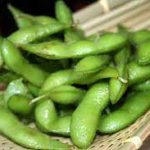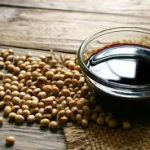In Japan S is for Soya
Don't be confused with the Tom's Food! alphabetical. Yes, I know we haven't done Q or R yet. When we get to S, we may do sprouts or succotash or some such, but that won't be for a while yet. We are in Japan, where S is undoubtedly for soya. With every day that passed I learned more, so much so that I ventured the opinion that a failed soya crop would see the country grind to a halt. But it seems to be hardy stuff and they have plenty in reserve, so no one was losing too much sleep.

Edamame Beans
What does soy or soya mean to you? Sauce, I'm guessing. Milk, if you're vegan or have an allergy. Anything else? Well let me talk you through a few things we ate on our travels. First night in Kyoto, we find ourselves in the touristy district of Pontocho. In summer, the restaurants all build platforms on stilts, offering a pleasant location overlooking the river. A beer comes with a snack of salty edamame beans in their pods. Edamame = soya. The raw beans of the soya plant are inedible. Edamame are immature beans boiled in salt, and very tasty they are too.
To understand many soya offshoots, consider an analogy with cheese. In the west tofu is often known as bean paste, the bean in question being soya. I once witnessed the manufacture of tofu in a tiny unit in a Hanoi market. The beans are boiled to produce soy milk. That is coagulated (don't ask me how), then the liquid (think whey) is removed leaving the curd like substance that is tofu. High in protein, low on flavour.
Leaving aside booze, we're not great fermenters here in the UK. But add the miracle that is koji, as they have been doing in Japan for thousands of years. As regular readers you know all about koji, since I wrote about Robin Sherriff and his Koji Kitchen last year. But not many do, and our guides were flabbergasted by our piece of useless information. Did I say useless? Nay. Take koji, add to soy and grains, let the fermentation do its magic and, lo and behold, you have miso. There are two main types of miso, white and red. Add miso paste to dashi (see last week's column) and you have miso soup, which will be served to you each and every meal, no matter how hard you beg them to stop.

Akamiso
We tasted miso paste in the same shop where we sampled various soy sauces. Akamiso (the red stuff) tastes very like soy sauce. I came away thinking that the sauce is a by-product of miso. I was also given a lot of disinformation about sake. Note to trainee journalists - check your sources. Soy sauce in fact comes from soy paste. No grain is used in its production. While the techniques are very similar, miso is slightly sweeter. (I'd no sooner written this than I came on a source which says that grain is used in the manufacture of soy sauce. Life is tricky.)
 If you're trying to explain to someone the concept of umami, the elusive fifth taste sensation, simply give them a teaspoon of soy sauce. Of dark soy sauce, that is. Light soy is saltier. One forgets that, depending on your terrain, the production of salt, something we take for granted, can be difficult and expensive. Travel round eastern markets and you will find light soy, dried shrimp, nam pla and others all vying for the salt cellar space.
If you're trying to explain to someone the concept of umami, the elusive fifth taste sensation, simply give them a teaspoon of soy sauce. Of dark soy sauce, that is. Light soy is saltier. One forgets that, depending on your terrain, the production of salt, something we take for granted, can be difficult and expensive. Travel round eastern markets and you will find light soy, dried shrimp, nam pla and others all vying for the salt cellar space.
My wife, no great fan of Japanese cuisine, will say that soy sauce was invented to take away the taste of sushimi (raw fish) or sushi. It certainly does bolster up a dull bowl of steamed rice, but go to Vietnam or Thailand and taste the magic of combinations of dark soy, fish sauce, lime juice, ginger and chilli. Can you really imagine a store cupboard without it?
We're not finished yet. Soybean oil has many important uses, increasingly as biodiesel. Then there's livestock feed, of course, from soybean meal. Somebody somewhere uses it for making vodka, surprise, surprise. In Indonesia they use soya to make something called tempeh. That sounds suspiciously like tofu, so let's move swiftly on.
We'll end the article as you might end a meal, with dessert. After our sushi class, also in Kyoto, I was served ice cream liberally dusted with a brown powder. Absolutely stunning. Hazelnut, I was fairly certain. Nope. Roasted soya powder, sweetened with icing sugar. I have a bag in the cupboard, ready for the next lucky guest.